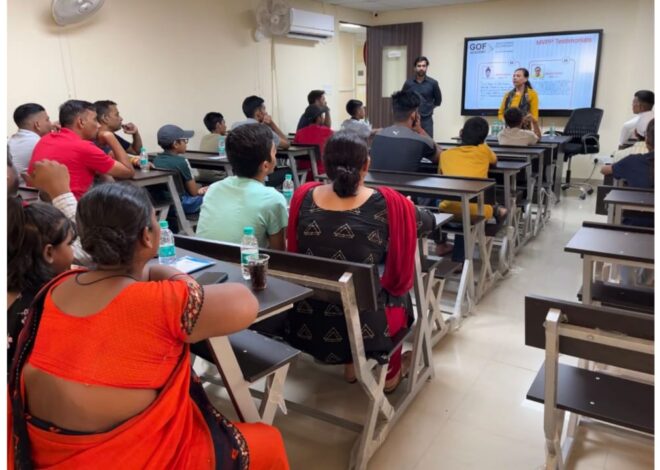
Last 5 Years Analysis of NEET Chemistry
Last 5 Years Analysis of NEET Chemistry by GOF Academy Dwarka For NEET Preparing Students
| Class | Unit No. | Unit Name | Chapter No. | Chapter Name | Topic | Sub Topic | 2023 | 2022 | 2021 | 2020 | 2019 | Total No. Of Questions |
| XI | I | Some Basic Concepts of Chemistry | 1 | Some Basic Concepts of Chemistry | Significant Figures, Laws of Chemical Combinations & Mole Concept | Mole Concept | 1 | 1 | 2 | |||
| Percent Composition & Empirical Formula | Empirical Formula | 1 | 1 | |||||||||
| Stoichiometric Calculations | Stoichiometric Calculations | 2 | 1 | 3 | ||||||||
| II | Structure of Atom | 2 | Structure of Atom | Atomic Models & Dual Nature of Electromagnetic Radiation | Electromagnetic Radiation | 1 | 1 | |||||
| Bohr’s Model of H atom | Subatomic Particles | 1 | 1 | |||||||||
| Absorption/Emission Spectra, Bohr’s Orbit Radius | 1 | 1 | 2 | |||||||||
| Dual Nature of Matter & Heisenberg Uncertainity Principle | Uncertaininty Principle/Orbital Stability/ DeBroglie Wavelength | 0 | ||||||||||
| Quantum Mechanical Model of Atom | Quantum Number, Orbital Energy | 1 | 1 | 2 | ||||||||
| III | Classification of Elements & Periodicity in Properties | 3 | Classification of Elements & Periodicity in Properties | Modern Periodic Table | Modern Periodic Table | 1 | 1 | 2 | ||||
| Periodic Trends in Properties of Elements | Periodic Trends in Properties of Elements | 1 | 1 | 1 | 3 | |||||||
| IV | Chemical Bonding & Molecular Structure | 4 | Chemical Bonding & Molecular Structure | Electrovalent, Covalent & Cooridnate Bonding | Octet Rule | 1 | 1 | |||||
| Dipole Moment & Bond Polarity | Dipole Moment & Bond Polarity | 1 | 1 | 2 | ||||||||
| VSEPR Theory & Hybridisation | Structures & Hybridisation VSEPR Theory | 1 | 1 | 2 | ||||||||
| Valence Band & Molecular Orbital Thoery | Valence Band & Molecular Orbital Thoery | 1 | 1 | 1 | 1 | 4 | ||||||
| V | States of Matter | 5 | States of Matter | Gas Laws & Ideal Gas Equation | Boyle’s Law | 1 | 1 | 2 | ||||
| Intermolecular Forces | 1 | 1 | ||||||||||
| Ideal Gas Equation | 1 | 1 | 2 | |||||||||
| Partial Pressure | 1 | 1 | ||||||||||
| Dalton’s Law of Partial Pressure | 1 | 1 | ||||||||||
| Vander Waals Equation & Liquefaction of Gases | Vander Waals Equation & Liquefaction of Gases | 1 | 1 | |||||||||
| VI | Thermodynamics | 6 | Thermodynamics | First Law & Fundamental of Thermodynamics | P-V Curve | 1 | 1 | |||||
| I law of Thermodynamics | 1 | 1 | 1 | 3 | ||||||||
| Cp & Cv | 1 | 1 | ||||||||||
| Entropy & Second Law of Thermodynamics | Entropy & Second Law of Thermodynamics | 1 | 1 | 2 | ||||||||
| VII | Equilibrium | 7 | Equilibrium | Law of Mass Action, Equilibrium constant & Its Application | Equilibrium constant/ Kp & Kc | 1 | 1 | |||||
| Relation between K, Q & G and factors affecting Equilibirum | Relation between K, Q & G and factors affecting Equilibirum | 1 | 1 | 2 | ||||||||
| Theories of Acids and Bases, Ionic Product of Water & pH scale | Lewis Acids & Bases | 1 | 1 | |||||||||
| Bronsted Acids & Bases | 1 | 1 | ||||||||||
| pH Scale | 1 | 1 | ||||||||||
| Ionisation of Weak Acids & Bases and relation between Ka & Kb | Ionisation of Weak Acids & Bases and relation between Ka & Kb | 1 | 1 | |||||||||
| Common Ion Effect, Salt Hydrolysis, Buffer Solution & Solubility Product | Solubility / Ksp | 1 | 2 | 3 | ||||||||
| Buffer Solution | 1 | 1 | ||||||||||
| VIII | Redox Reactions | 8 | Redox Reactions | Oxidation & Reduction Reactions | Metal Displacement | 1 | 1 | |||||
| Oxidation Number | Oxidation Number | 1 | 1 | |||||||||
| Disproportionation Reaction & Balancing of Redox Reactions | Disproportionation Reaction & Balancing of Redox Reactions | 1 | 1 | 2 | ||||||||
| Electrode Potential & Oxidising, Reducing Agents | Electrode Potential & Oxidising, Reducing Agents | 1 | 1 | |||||||||
| IX | Hydrogen | 9 | Hydrogen | Preparation & Properties of Hydrogen | Uses of Hydrogen | 1 | 1 | |||||
| Nature of Hydrides | 1 | 1 | ||||||||||
| Isotopes of Hydrogen | 1 | 1 | ||||||||||
| Properties of Hydrogen | 0 | |||||||||||
| Preparation & Properties of Water | Hardness of Water | 1 | 1 | |||||||||
| X | s- block Elements | 10 | s-block Elements | Preparation & Properties of Alkali Metals & Their Compounds | Preparation of Alkali Metals | 1 | 1 | 2 | ||||
| Uses of Alkali Metals & their Compounds | 1 | 1 | ||||||||||
| Biological Importance of Alkali Metals | 1 | 1 | ||||||||||
| Some Important Compunds of Sodium | Properties of Sodium Chloride | 1 | 1 | |||||||||
| Preparation & Properties of Alkaline Earth Metals & Their Compounds | Properties of Alkaline Earth Metal Compounds | 2 | 2 | 4 | ||||||||
| Some Important Compunds of Calcium | Biological Importance of Alkali Metals | 1 | 1 | |||||||||
| XI | The p-block Elements (Group 13 & Group 14) | 11 | The p-block Elements | Boron Family | Inert pair Effect | 1 | 1 | |||||
| Structure of Diborane | 1 | 1 | ||||||||||
| Multiple Concept (Structure, Formulae) | 1 | 1 | ||||||||||
| Physical/Chemical Properties of Group 13 | 0 | |||||||||||
| Carbon Family | Allotropes of Carbon | 1 | 1 | 2 | ||||||||
| Oxides of Carbon | 2 | 2 | ||||||||||
| Properties of Halides of Group 14 | 2 | 2 | ||||||||||
| XII | Organic Chemistry – Some Basic Principles & Techniques | 12 | Organic Chemistry – Some Basic Principles & Techniques | Classification & Nomenclature of Organic Compounds | Structure of Organic Compound | 1 | 1 | |||||
| IUPAC Nomenclature/Structure | 1 | 1 | ||||||||||
| Isomerism in Organic Compounds | Metamerism | 1 | 1 | |||||||||
| Concept of Reaction Mechanism in Organic Compounds | Quantitative Analysis | 1 | 1 | |||||||||
| Quantitative Estimation | 1 | 1 | ||||||||||
| Stability of Carbocation/Carboanion | 1 | 1 | ||||||||||
| Chromatography/Distillation | 1 | 1 | ||||||||||
| Electrophilic Substitution Reaction | 1 | 1 | ||||||||||
| Inductive Effect | 0 | |||||||||||
| XIII | Hydrocarbons | 13 | Hydrocarbons | Alkanes | Preparation | 1 | 1 | |||||
| Conversion (Substitution/Wurtz Reaction) | 0 | |||||||||||
| Conformations of Ethane | 1 | 1 | ||||||||||
| Alkenes | Peroxide Effect | 1 | 1 | |||||||||
| Ozonolysis | 1 | 1 | 1 | 3 | ||||||||
| Alkynes | Reduction of Alkyne | 1 | 1 | |||||||||
| Order of Acidity/Acidic Character | 0 | |||||||||||
| Hydration Reaction | 0 | |||||||||||
| Aromatic Hydrocarbons | Aromaticity | 1 | 1 | 2 | ||||||||
| XIV | Environmental Chemistry | 14 | Environmental Chemistry | Air Pollution | Green House Effect | 1 | 1 | |||||
| Air Pollution | 1 | 1 | 2 | |||||||||
| Water & Soil Pollution | Water Pollution | 1 | 1 | |||||||||
| Soil Pollution | 0 | |||||||||||
| XII | I | The Solid State | 1 | The Solid State | Crystal Structure of Solids | Bravais Lattice | 1 | 1 | ||||
| Cubic System & Packing Efficiency | Relation between r & a | 1 | 1 | |||||||||
| Formula of Compound & Voids | 2 | 1 | 1 | 4 | ||||||||
| Density Ratio & Structure | 1 | 1 | ||||||||||
| Imperfection in Solids | Defects | 1 | 1 | |||||||||
| II | Solutions | 2 | Solutions | Solubility & Concentration of Solutions | Concentration of Solution | 1 | 1 | |||||
| Effect of temperature on Molality/Molarity/Mole Fraction | 0 | |||||||||||
| Vapour Pressure, Law of Solutions, Ideal & Non Ideal Solutions | Raoult’s Law | 1 | 1 | |||||||||
| Azeotropes | 1 | 1 | ||||||||||
| Vapour Pressure | 1 | 1 | ||||||||||
| Colligative Properties & Abnormal Molecular Masses | Molality & Kf | 0 | ||||||||||
| Osmotic Pressure | 1 | 1 | ||||||||||
| Depression in Freezing Point | 1 | 1 | ||||||||||
| III | Electrochemistry | 3 | Electrochemistry | Conductance & Conductivity | Cell Constant | 1 | 1 | |||||
| Ionic Mobility | 0 | |||||||||||
| Molar Conductivity at Infinite Dilution | 2 | 2 | ||||||||||
| Electrolysis & Faraday’s Law | Electrolysis | 1 | 1 | |||||||||
| Faraday’s Law | 1 | 1 | ||||||||||
| Gibbs Free Energy of Cell | 1 | 1 | ||||||||||
| Cells& Electrode Potential , Nerst Equation | Relation between Equilibrium Constant and Ecell | 1 | 1 | |||||||||
| Relation between equilibrium constant and Gibbs Energy | 1 | 1 | ||||||||||
| Electrode Potential | 1 | 1 | ||||||||||
| Nerst Equation | 1 | 1 | ||||||||||
| IV | Chemical Kinetics | 4 | Chemical Kinetics | Rate of Reaction, Rate Laws & Rate Constant | Rate of Reaction | 1 | 1 | 2 | ||||
| Order of Reaction & Half Period | Difference between first & second order reaction | 0 | ||||||||||
| first order reaction rate law | 1 | 1 | 1 | 3 | ||||||||
| Half life of zero orde reaction | 1 | 1 | ||||||||||
| order of the reaction | 0 | |||||||||||
| half life of first order reaction | 0 | |||||||||||
| Graphical Representation | 1 | 1 | ||||||||||
| Theories of Rate of Reaction | Activation Energy | 1 | 1 | |||||||||
| Collision Frequency | 1 | 1 | ||||||||||
| Effect of Catalyst | 0 | |||||||||||
| Potential Energy Profile | 1 | 1 | ||||||||||
| Arrhenius Plot | 1 | 1 | ||||||||||
| V | Surface Chemistry | 5 | Surface Chemistry | Adsorption | Chracteristics of Adsorption | 0 | ||||||
| Catalysts & Theories of Catalysts | Heterogeneous & Homogeneous Catalysts | 1 | 1 | |||||||||
| Catalysts or enzymes | 1 | 1 | ||||||||||
| Colloids & Emulsions | Tyndall Effect | 1 | 1 | |||||||||
| Zeta Potential | 1 | 1 | ||||||||||
| Colloidal Solutions | 1 | 1 | ||||||||||
| Coagulation | 1 | 1 | ||||||||||
| VI | General Principles and Processes of Isolation of Elements | 6 | General Principles and Processes of Isolation of Elements | Occurrence of Metals | Occurrence of Metals | 1 | 1 | 2 | ||||
| Metallurgical Processes | Metallurgical Processes | 1 | 1 | 1 | 3 | |||||||
| Ellingham Diagram | 0 | |||||||||||
| Purification & Uses of Metal | Purification | 1 | 1 | 2 | ||||||||
| VII | The p-block Elements (Group 15, 16, 17 & 18) | 7 | The p-block Elements (Group 15, 16, 17 & 18) | Nitrogen Family | Oxidation states in N compounds | 0 | ||||||
| Acid Strength of Oxophosphorous Acid | 0 | |||||||||||
| Chemical Reactions of Nitrogen/Nitrogen Compounds | 1 | 1 | ||||||||||
| Oxygen Family | Oxoacids of Sulphur | 1 | 1 | 1 | 3 | |||||||
| b.p/stability order of hydrides | 1 | 1 | ||||||||||
| Halogen Family | Preparation Processes | 1 | 1 | |||||||||
| Structure of PCl5 | 0 | |||||||||||
| Interhalogen Compounds | 1 | 1 | ||||||||||
| Bond Dissociation Enthalpy/Acid Strength | 1 | 1 | ||||||||||
| Oxoacids/Oxidation states/Electron Affinity | 1 | 1 | ||||||||||
| Noble Gases | Properties of Noble Gas | 1 | 1 | 2 | ||||||||
| Hybridisation & Strcutures of Noble Gas Compounds | 0 | |||||||||||
| VIII | The d & f block elements | 8 | The d & f block elements | Characteristics of d-block elements | Properties of d-block elements | 1 | 1 | |||||
| Stability of Ions in Aqueous Solutions | 1 | 1 | ||||||||||
| Size & Shape of d-orbital | 1 | 1 | ||||||||||
| d-d transition & Paramagnetism | 0 | |||||||||||
| Catalytic activities/oxidation states/reducing properties | 1 | 1 | 2 | |||||||||
| Compounds of Transition Elements | Properties of KMnO4 | 1 | 1 | |||||||||
| Properties of K2Cr2O7 | 0 | |||||||||||
| Reactions of Copper | 0 | |||||||||||
| Lanthanoids & Actinoids | Characteritics of Actinoids/Lanthanoids | 1 | 1 | 2 | ||||||||
| Electronic Configuration | 0 | |||||||||||
| Lanthanoid Configuration | 1 | 1 | ||||||||||
| IX | Coordination Compounds | 9 | Coordination Compounds | Coordination Number, Nomenclature & Isomerism of Coordination Compounds | Heteroleptic & Homoleptic Complexes | 1 | 1 | |||||
| Types of Ligands/IUPAC | 1 | 1 | 2 | |||||||||
| Isomerism | 0 | |||||||||||
| Primary/Secondary Valency | 0 | |||||||||||
| Magnetic Moment, Valence Band Theory & Crystal Field Theory | Ligand Strength | 1 | 1 | |||||||||
| Magnetic Moment | 1 | 1 | 2 | |||||||||
| Crystal Field Theory | 1 | 1 | ||||||||||
| Complex Formation/Colour | 1 | 1 | 2 | |||||||||
| Geometry/Hybridisation & Magnetic Behaviour | 0 | |||||||||||
| Metal Carbonyls and Its Uses | Metal Carbonyls/Organometallic Compounds | 0 | ||||||||||
| X | Haloalkanes & Haloarenes | 10 | Haloalkanes & Haloarenes | Preparation & Properties of Haloalkanes | Classification | 1 | 1 | |||||
| Bond Enthalpy | 1 | 1 | ||||||||||
| Dehydrogenation | 1 | 1 | ||||||||||
| Elimination Reaction/Substitution Reaction | 1 | 1 | 2 | |||||||||
| Wurtz Reaction | 1 | 1 | ||||||||||
| Preparation & Properties of Haloarenes | Preparation of Haloarene | 1 | 1 | |||||||||
| Hydrolysis Reaction | 1 | 1 | ||||||||||
| Optical Activity in Biphenyls | 0 | |||||||||||
| XI | Alcohols, Phenols & Ethers | 11 | Alcohols, Phenols & Ethers | Preparation and Properties of Alcohols | Reaction with Haloacid | 1 | 1 | |||||
| Dehydration | 1 | 1 | ||||||||||
| Lucas Reagent Test | 1 | 1 | ||||||||||
| Reaction with Grignard Reagent | 1 | 1 | ||||||||||
| Conversion Reaction with Na/PCl5/ether formation | 0 | |||||||||||
| Preparation & Properties of Phenols | Preparation of Phenols | 1 | 1 | |||||||||
| Reimer-Tieman Reaction | 0 | |||||||||||
| Haloform Reaction | 0 | |||||||||||
| Conversion (Reaction with AlCl3/Ozonolysis) | 0 | |||||||||||
| Effect of Substituents/Acidity Order | 1 | 1 | ||||||||||
| Preparation & Properties of Ethers | Cleavage with HI | 1 | 1 | 2 | ||||||||
| Protonation of Ether | 1 | 1 | ||||||||||
| Williamson Synthesis | 0 | |||||||||||
| Substitution Reactions | 0 | |||||||||||
| XII | Aldehydes, Ketones & Carboxylic Acids | 12 | Aldehydes, Ketones & Carboxylic Acids | Methods of Preparation of Carbonyl Compounds | Etard’s Reaction | 1 | 1 | |||||
| Preparation of Benzaldehyde | 1 | 1 | ||||||||||
| Properties of Carbonyl Compounds | Name Reactions | 1 | 1 | |||||||||
| Physical Properties | 1 | 1 | ||||||||||
| Chemical Properties | 2 | 1 | 3 | |||||||||
| Reduction Oxidation | 1 | 1 | ||||||||||
| Reaction with Grignard Reagent | 1 | 1 | ||||||||||
| Aldol/Cross Aldol/Condensation | 1 | 1 | 2 | |||||||||
| Conversion (Semicarbazone/Aldol Condensation) | 0 | |||||||||||
| Keto enol tautomerism | 0 | |||||||||||
| Reaction with Name | 0 | |||||||||||
| Preparation & Properties of Carboxylic Acids | Decarboxylation | 1 | 1 | |||||||||
| Reaction with Ammonia | 0 | |||||||||||
| Physical Properties | 0 | |||||||||||
| XIII | Amines | 13 | Amines | Aliphatic & Aromatic Compounds | Hinsberg’s Reagent | 1 | 1 | 2 | ||||
| Carbylamine Reaction | 1 | 1 | ||||||||||
| Basic Strength of Amines | 1 | 1 | ||||||||||
| Hoffmann Bromamide Reaction | 1 | 1 | ||||||||||
| Electrophilic Substitution | 0 | |||||||||||
| Nitro Compounds, Alkyl Nitrite & Diazonium Salts | Preparation of Isocyanides | 1 | 1 | |||||||||
| Diazonium Salts | 1 | 1 | 1 | 3 | ||||||||
| XIV | Biomolecules | 14 | Biomolecules | Carbohydrates & Lipids | Hydrolysis of Sucrose | 1 | 1 | |||||
| Amino Acids & Proteins | Denaturation of Proteins | 1 | 1 | |||||||||
| Aminoacids/Proteins | 1 | 2 | 3 | |||||||||
| Nucleic Acids & Enzymes | Structure of Nucleic Acids | 1 | 1 | |||||||||
| Vitamins & Hormones | Deficiency Disease | 1 | 1 | |||||||||
| XV | Polymers | 15 | Polymers | Classification of Polymers | Natural Polymers | 1 | 1 | |||||
| Biodegradable Polymers | 1 | 1 | ||||||||||
| Preparation & Properties of Polymers | Preparation of Polymers | 1 | 1 | |||||||||
| Properties of Polymers | 1 | 1 | 2 | |||||||||
| XVI | Chemistry in Everyday Life | 16 | Chemistry in Everyday Life | Drugs & Their Classification | Tanquilizers | 1 | 1 | |||||
| Classification | 1 | 1 | ||||||||||
| Therapeutic Action of Drugs | 1 | 1 | 2 | |||||||||
| Cleansing Agents | Detergents | 1 | 1 |








